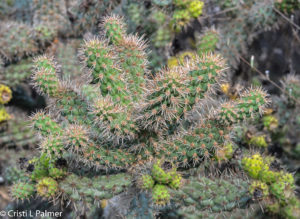Plant Information
A cactus (plural cacti, cactuses, or less commonly, cactus) is a member of the flowering plant family Cactaceae, a family comprising about 139 genera with nearly 2,000 known species of the order Caryophyllales. The word “cactus” derives, through Latin, from the ancient ancient Greek, kaktos, a name originally used for a spiny plant whose identity is now not certain. No known fossils of cacti exist to throw light on their evolutionary history. However, the geographical distribution of cacti suggests that the family must have evolved around 35–30 million years ago. Almost all cacti are succulents, meaning they have thickened, fleshy parts adapted to store water. Most live in desert or semi-desert environments and have many special adaptations in order to survive and thrive in hot, dry conditions. Cacti are originally native to the North and South American continents, ranging from Patagonia in the south to parts of western Canada in the north—except for Rhipsalis baccifera, which also grows in Africa and Sri Lanka. The most dense occurrence of cacti is to be found in the territories around northern Mexico and the southern tropic (Argentina and Bolivia). The equivalent plants to cacti in Africa and Australia are representatives of the so-called “other succulents” (like aloe vera, jade plant, snake plant, hens-and-chicks and stonecrop).
Various species of cactus, notably prickly pears (Opuntia spp.) and chollas (Cylindopuntia spp.), are cultivated as food. Cochineal is a red dye produced by a scale insect that lives on species of Opuntia; commercial production has now increased following a rise in demand for natural dye. In Central and South America, species of Opuntia, Cereus, and others are used as living fences, and wood from columnar cacti is used as fuel in some desert regions. The woody parts of cacti, such as Cereus repandus and Echinopsis atacamensis, are used in buildings and in furniture. The very fine spines and hairs (trichomes) of some cacti were used as a source of fiber for filling pillows and in weaving. In times of drought, the spines are removed from cacti such as mandacaru (Cereus jamacaru) to use as fodder for livestock. Peyote, from Lophophora williamsii, has been used ceremonially since pre-Columbian times for its hallucinogenic properties, and many cactus species are of local importance in traditional medicine.
In the twentieth and twenty–first centuries, cacti began to be especially favored as garden plants in arid climates because of their ability to thrive with little or no irrigation. They require little maintenance and may provide food for native wildlife. Some species do well in areas with very cold winters. Cacti have become popular as indoor houseplants, including various South American tree-growing species with large, long-lasting flowers which are known as orchid cacti (Epiphyllum spp.) and Christmas cacti (Schlumbergera spp.). Some popular types of cacti found in landscape settings include: prickly pear cacti (Opunta spp.), barrel cacti (two genera Echinocactus and Ferocactus), cholla cacti (Opunta spp.), pincushion cacti (Mammillaria spp.), totem pole cactus (Lophocereus schottii f. monstrosus) and Organ pipe cactus (Stenocereus thurberi). Popular indoor cactus varieties include ‘Bunny Ear’ (Opuntia microdasys), ‘Old Lady’ (Mammillaria hahniana), ‘Easter’ (Hatiora gaertneri), ‘Star’ (Astrophytum asteria), ‘Christmas’ (Schlumbergera bridgesii), ‘Moon’ (Gymnocalycium mihanovichii), and ‘Saguaro’ cactus (Carnegiea gigantea).
Most cactus plants are purchased already growing, so planting for indoors is just adding it to a suitable pot. Cactus plants grow very slowly, so pots that are just large enough to contain the plant are all that’s needed. Soils for cacti should be fast-draining, so regular potting mix will probably not work well. Special cactus-specific potting soils are available or a mix of sand to standard potting soil in a 1:4 ratio can be used. They prefer a growing space with plenty of sunlight. Proper watering is very important to growing cacti. Allow excess water to drain when plant is actively growing (usually in spring and summer); in the winter when plants generally rest, water very little – perhaps once every couple of weeks or even once a month. Fertilize plants several times during the growth period with liquid 10-10-10 fertilizer or one labelled for cacti and succulents. When growing cactus outdoors, plant in a sunny location in well-drained soil specially formulated for cactus plants. This can be purchased or mixed with using two parts potting soil, two parts sand, and one part gravel. Cactus plants also enjoy a moderate layer of mulch such as pebbles, rocks, or similar substance. Once established, cacti require little maintenance and very little, if any, water. Fertilize once a year with a 10-10-10 fertilizer or a good plant food.
Economics
According to the USDA NASS Census of Horticulture, cacti and succulents sold for a wholesale value of $70.8M in 2019.
Main Disease Problems
Cacti have several main disease problems including bacterial soft rot, Phytophthora and Pythium root rots, Phyllosticta pad spot, cactus stem spot, Phomopsis dieback, anthracnose, basal stem rot, Botrytis blight, and impatiens necrotic spot virus.
Main Pest Problems
Cacti have a variety of pests including aphids, cactus borers, cactus bugs, spider mites, scale insects, mealybugs, thrips, and whiteflies.
IR-4 Research
IR-4 has sponsored 24 crop safety trials with 16 products.
Sources Cited
https://en.wikipedia.org/wiki/Cactus
https://www.britannica.com/plant/cactus
https://www.newworldencyclopedia.org/entry/Cactus
https://www.gardeningknowhow.com/ornamental/cacti-succulents/scgen/cactus-landscaping.htm
https://www.gardeningknowhow.com/ornamental/cacti-succulents/scgen
https://www.thespruce.com/best-cactus-to-plant-in-garden-4059807
https://aggie-horticulture.tamu.edu/databases/cactus/growingcactus/#:~:text=Cacti%20are%20a%20group%20of,varieties%20may%20be%20grown%20outside.
https://www.gardeningchannel.com/how-to-grow-cactus-plants/
https://www.thespruce.com/how-to-grow-cactus-1902954
https://aggie-horticulture.tamu.edu/plantanswers/trees/cactus.html
https://cactusway.com/can-a-cactus-grow-indoors/
https://pss.uvm.edu/ppp/articles/cacti.html
https://extension.psu.edu/christmas-cactus-diseases
https://www.nexles.com/articles/cactus-cactaceae-treatments-common-diseases-pests-flower/
https://chinlecactusclub.org/plant-watering/pests-diseases/
https://gardenerspath.com/how-to/disease-and-pests/christmas
USDA-NASS Census of Horticulture, 2019
Authors
Ely Vea, IR-4 Environmental Horticulture Program Assistant Manager and Cristi Palmer, IR-4 Environmental Horticulture Program Manager.
